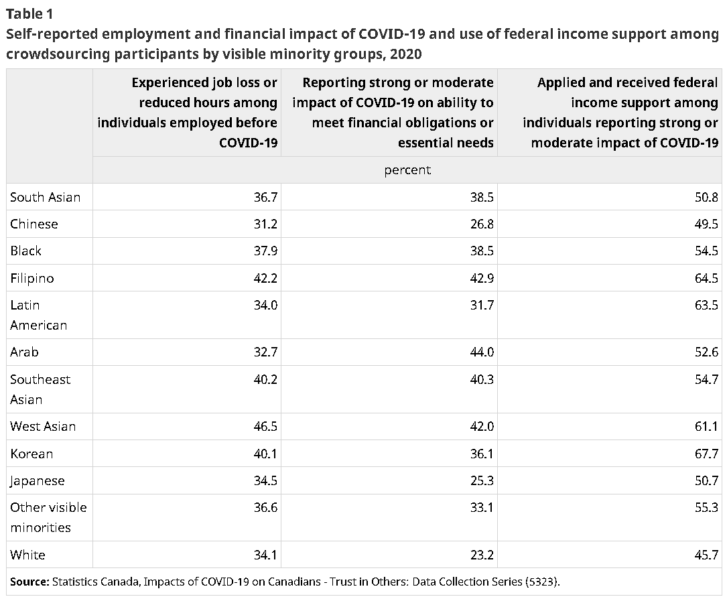The economic lockdown triggered by COVID-19 has led so far to disproportionate employment losses among lower-paid workers and young workers. Its impact on visible minorities is currently less known. Since visible minorities often have lower incomes and more precarious employment than the White population (Block et al. 2019; Lightman and Gingrich 2018), their ability to buffer the income losses due to work interruptions is likely more limited. This study examines whether this is the case or not, shedding light on the economic impact of the COVID-19 pandemic on different visible minority groups.
The article first uses 2016 census data to compare group differences in poverty rates, thereby offering an assessment of economic vulnerability prior to the COVID-19 pandemic. Using data from a large crowdsourcing data collection initiative, the study further compares the degree to which visible minority participants: a) experienced job loss or reduced work hours since the onset of the pandemic, b) were strongly or moderately impacted financially, and c) applied for and received federal income support.
Most visible minorities had high poverty rates prior to the COVID-19 pandemic
Under robust macro-economic conditions, most visible minority groups are more likely to live in poverty than the White population. Among the population aged 15 and over, the poverty rate was 9.6% among the White population in the 2016 Census (Chart 1). In comparison, among Korean, Arab, and West Asian Canadians, the poverty rate ranged from 27% to 32%. Among Black and Chinese-Canadians, the poverty rate reached 20%. Filipinos were the only visible minority group that had a lower poverty rate.
The large gaps in the poverty rates between visible minority groups and the White population were partly related to immigration status. About one-third of Koreans, Arabs, and West Asians and one-fifth to one-quarter of Chinese, Blacks, and South Asians were recent immigrants. Recent immigrants were much more likely to be in poverty than long-term immigrants and the Canadian born. When group differences in immigration status, official language knowledge, education, employment status, and other demographic characteristics are taken into account, the gaps in the poverty rate between visible minorities and the White population decrease, but remain large (Chart 1).

Crowdsourcing participants from visible minorities report being more vulnerable to the financial impact of COVID-19
From May 26 to June 8, over 36,000 Canadians completed an online crowdsourcing questionnaire on social trust in the wake of the COVID-19 pandemic. Note that crowdsourcing data are not based on a probability sampling design, and the findings should not be inferred to the overall Canadian population.
Crowdsourcing participants were asked whether they have experienced temporary or permanent job loss or reduced work hours since the COVID-19 pandemic. Among participants who were employed prior to the shutdown, around one-third in most groups experienced job loss or reduced work hours (Table 1). Filipinos and West Asians reported a higher share, at 42% and 47%, respectively, compared to 34% among White participants.
The crowdsourcing questionnaire further asked participants about the impact of COVID-19 on their ability to meet financial obligations or essential needs, such as rent or mortgage payments, utilities, and groceries. Most visible minority groups had higher shares reporting a strong or moderate negative financial impact of COVID-19 than White participants (23%, Table 1). The share was particularly high among Arabs, West Asians, and Filipinos (42% or higher). Arabs and West Asians had the highest poverty rates prior to the pandemic, while West Asians and Filipinos had the highest rates of job loss or reduced work hours. The differences between most visible minority groups and White participants in the financial impact of COVID-19 remained large after taking into consideration their differences in job loss, immigration status, pre-COVID employment status, and other demographic characteristics.

About 19% of the crowdsourcing participants have applied for federal income support such as the Canada Emergency Response Benefit, Employment Insurance, or other programs. Essentially all of the applicants (95%) received support. Among participants who reported a strong or moderate impact of COVID-19, South Asians, Chinese, and Japanese reported similar rates of applying for and receiving federal income support as White participants, while other visible minority groups reported higher rates. The rate was particularly high among Filipinos (65%) and Koreans (68%).
Receiving federal income support was associated with a higher level of trust in governments and health authorities to make good decisions about when and how to reopen workplaces and public spaces, while reporting a strong or moderate financial impact of COVID-19 was associated with a lower level of trust. However, despite group differences in these factors, most visible minority groups reported a similar level of trust in government and health authorities as White participants.Note
Summary
High poverty rates among most visible minority groups prior the COVID-19 pandemic make them vulnerable to the financial impact of work disruptions. Among the crowdsourcing participants who were employed prior to work stoppages, Whites and most visible minority groups reported similar rates of job loss or reduced work hours, although the rate was higher among Filipinos and West Asians. However, the COVID-19 pandemic generally had a stronger impact on visible minority participants’ ability to meet financial obligations or essential needs than for White participants, even after taking into account group differences in job loss, immigration status, pre-COVID employment status, education, and other demographic characteristics.
References
Block, S., G-E. Galabuzi, and R. Tranjan. 2019. Canada’s Colour Coded Income Inequality. Ottawa: Canadian Centre for Policy Alternatives. ISBN 978-1-77125-478-6.
Lightman, N. and L. G. Gingrich. 2018. Measuring Economic Exclusion for Racialized Minorities, Immigrants, and Women in Canada: Results from 2000 and 2010. Journal of Poverty 22(5): 398-420.
Article From: StatCan COVID-19
Author: Feng Hou, Kristyn Frank and Christoph Schimmele

